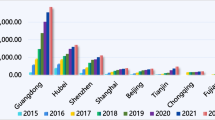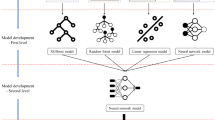Abstract
Carbon financial futures have both the characteristics of commodity futures and environmental protection and its price is affected by many factors. It is hard and complex for traditional analysis methods to get precise prediction results effectively. How to effectively predict the price trend of carbon financial futures has been focused on by both academia and traders. This study addresses the high prediction error of European allowance (EUA) futures price by constructing a novel approach by combining the support vector machine (SVM) and particle swarm optimization (PSO) algorithm. This article introduces a parameters optimization method, which provides the best parameters for SVM to improve the prediction performance of the EUA futures price. Furthermore, this research uses the realistic trading dataset containing 30,762 EUA futures closing prices to verify the effectiveness and efficiency of the PSO-SVM prediction model. The empirical results show that the prediction performance of the model, especially the radial kernel function, is significantly improved. And this approach can determine the parameters according to the characteristics of the dataset and input the parameters for training and prediction automatically. The PSO-SVM algorithm can effectively predict extreme price fluctuations and overcome the problem of high prediction error caused by parameter constraints.













Similar content being viewed by others
Explore related subjects
Discover the latest articles, news and stories from top researchers in related subjects.References
Aggarwal D, Chandrasekaran S, Annamalai B (2020) A complete empirical ensemble mode decomposition and support vector machine-based approach to predict Bitcoin prices. J Behav Exp Financ. https://doi.org/10.1016/j.jbef.2020.100335
Benítez-Peña S, Blanquero R, Carrizosa E, Ramírez-Cobo P (2019) Cost-sensitive feature selection for support vector machines. Comput Oper Res 106:169–178. https://doi.org/10.1016/j.cor.2018.03.005
Benz E, Trück S (2009) Modeling the price dynamics of CO2 emission allowances. Energy Econ 31:4–15. https://doi.org/10.1016/j.eneco.2008.07.003
Bouacha K, Terrab A (2016) Hard turning behavior improvement using NSGA-II and PSO-NN hybrid model. Int J Adv Manuf Technol 86:3527–3546. https://doi.org/10.1007/s00170-016-8479-6
Carrizosa E, Nogales-Gómez A, Romero Morales D (2017) Clustering categories in support vector machines. Omega 66:28–37. https://doi.org/10.1016/j.omega.2016.01.008
Chang C-L, McAleer M (2019) Modeling latent carbon emission prices for Japan: theory and practice. Energies. https://doi.org/10.3390/en12214222
Chevallier J, Sévi B (2013) On the stochastic properties of carbon futures prices environmental and resource. Economics 58:127–153. https://doi.org/10.1007/s10640-013-9695-2
Chiu YH, Lin JC, Su WN, Liu JK (2014) An efficiency evaluation of the EU’s allocation of carbon emission allowances. Energy Sources Part B 10:192–200. https://doi.org/10.1080/15567249.2010.527900
Cortes C, Vapnik V (1995) Support-vector networks. Mach Learn 20:273–297. https://doi.org/10.1007/bf00994018
Cucchiella F, D’Adamo I, Gastaldi M, Miliacca M (2018) Efficiency and allocation of emission allowances and energy consumption over more sustainable. Eur Econ J Clean Prod 182:805–817. https://doi.org/10.1016/j.jclepro.2018.02.079
Daskalakis G, Psychoyios D, Markellos RN (2009) Modeling CO2 emission allowance prices and derivatives: evidence from the European trading scheme. J Bank Finance 33:1230–1241. https://doi.org/10.1016/j.jbankfin.2009.01.001
Dutta A, Jalkh N, Bouri E, Dutta P (2019) Assessing the risk of the European Union carbon allowance market. Int J Manage Finance 16:49–60. https://doi.org/10.1108/ijmf-01-2019-0045
Eberhart RC, Shi Y (1998) Comparison between genetic algorithms and particle swarm optimization. In: International conference on evolutionary programming. Springer, pp 611–616. https://doi.org/10.1007/BFb004081
Erdoğan Z, Namlı E (2019) A living environment prediction model using ensemble machine learning techniques based on quality of life index. J Ambient Intell Humaniz Comput. https://doi.org/10.1007/s12652-019-01432-w
Escamilla-Salazar IG, Torres-Treviño LM, González-Ortíz B, Zambrano PC (2012) Machining optimization using swarm intelligence in titanium (6Al 4V) alloy. Int J Adv Manuf Technol 67:535–544. https://doi.org/10.1007/s00170-012-4503-7
Fang C, Ma T (2019) Technology adoption with carbon emission trading mechanism: modeling with heterogeneous agents and uncertain carbon price. Ann Oper Res. https://doi.org/10.1007/s10479-019-03297-w
García A, García-Álvarez MT, Moreno B (2020) The impact of EU allowance prices on the stock market indices of the European power industries: evidence from the ongoing EU ETS phase III. Organ Environ. https://doi.org/10.1177/1086026620924820
Geng R, Bose I, Chen X (2015) Prediction of financial distress: an empirical study of listed Chinese companies using data mining. Eur J Oper Res 241:236–247. https://doi.org/10.1016/j.ejor.2014.08.016
Ghaddar B, Naoum-Sawaya J (2018) High dimensional data classification and feature selection using support vector machines. Eur J Oper Res 265:993–1004. https://doi.org/10.1016/j.ejor.2017.08.040
Gheisari S, Meybodi MR (2016) BNC-PSO: structure learning of Bayesian networks by particle. Swarm Optim Inf Sci 348:272–289. https://doi.org/10.1016/j.ins.2016.01.090
Hájek M, Zimmermannová J, Helman K, Rozenský L (2019) Analysis of carbon tax efficiency in energy industries of selected EU countries. Energy Policy. https://doi.org/10.1016/j.enpol.2019.110955
Hammoudeh S, Nguyen DK, Sousa RM (2014) Energy prices and CO2 emission allowance prices: a quantile regression approach. Energy Policy 70:201–206. https://doi.org/10.1016/j.enpol.2014.03.026
Hao P-Y, Kung C-F, Chang C-Y, Ou J-B (2021) Predicting stock price trends based on financial news articles and using a novel twin support vector machine with fuzzy hyperplane. Appl Soft Comput. https://doi.org/10.1016/j.asoc.2020.106806
Harasheh M, Amaduzzi A (2019) European emission allowance and equity markets: evidence from further trading phases. Stud Econ Financ 36:616–636. https://doi.org/10.1108/sef-02-2018-0058
He Y, Wan J (2020) Flood hazard assessment based on fuzzy clustering iterative model and chaotic particle swarm optimization. J Ambient Intell Humaniz Comput. https://doi.org/10.1007/s12652-020-02109-5
Hong K, Jung H, Park M (2017) Predicting European carbon emission price movements. Carbon Manage 8:33–44. https://doi.org/10.1080/17583004.2016.1275813
Jaramillo-Morán MA, García-García A (2019) Applying artificial neural networks to forecast European Union allowance prices: the effect of information from pollutant-related sectors. Energies. https://doi.org/10.3390/en12234439
Jordehi AR (2015) Enhanced leader PSO (ELPSO): a new PSO variant for solving global optimisation problems. Appl Soft Comput 26:401–417. https://doi.org/10.1016/j.asoc.2014.10.026
Jun T, Jian Y (2005) Developing an intelligent data discriminating system of anti-money laundering based on SVM. In: 2005 International Conference on Machine Learning and Cybernetics, Vol. 3456, 18–21 Aug. 2005. pp 3453–3457. https://doi.org/10.1109/ICMLC.2005.1527539
Kennedy J, Eberhart R (1995) Particle swarm optimization. In: Proceedings of ICNN'95—International Conference on Neural Networks, vol. 1944, 27 Nov.-1 Dec. 1995. pp 1942–1948. https://doi.org/10.1109/ICNN.1995.488968
Kennedy J, Eberhart RC (1997) A discrete binary version of the particle swarm algorithm. In: 1997 IEEE International conference on systems, man, and cybernetics. Computational cybernetics and simulation. IEEE, pp 4104–4108. https://doi.org/10.1109/ICSMC.1997.637339
Kirat D, Ahamada I (2011) The impact of the European Union emission trading scheme on the electricity-generation sector. Energy Econ 33:995–1003. https://doi.org/10.1016/j.eneco.2011.01.012
Koop G, Tole L (2013) Forecasting the European carbon market. J R Stat Soc A Stat Soc 176:723–741. https://doi.org/10.1111/j.1467-985X.2012.01060.x
Li L-L, Chang Y-B, Tseng M-L, Liu J-Q, Lim MK (2020) Wind power prediction using a novel model on wavelet decomposition-support vector machines-improved atomic search algorithm. J Clean Prod 270:121817. https://doi.org/10.1016/j.jclepro.2020.121817
Lin B, Jia Z (2019) Impacts of carbon price level in carbon emission trading market. Appl Energy 239:157–170. https://doi.org/10.1016/j.apenergy.2019.01.194
Lu W, Peng Q, Cui Y, Huang Z, Teng J, Hu W (2020) Structural response estimation method based on particle swarm optimisation/support vector machine and response correlation characteristics. Measurement 160:107810. https://doi.org/10.1016/j.measurement.2020.107810
Paolella MS, Taschini L (2008) An econometric analysis of emission allowance prices. J Bank Finance 32:2022–2032. https://doi.org/10.1016/j.jbankfin.2007.09.024
Rao RV, Kalyankar VD (2014) Optimization of modern machining processes using advanced optimization techniques: a review. Int J Adv Manuf Technol 73:1159–1188. https://doi.org/10.1007/s00170-014-5894-4
Reboredo JC (2013) Modeling EU allowances and oil market interdependence. Implications for portfolio management. Energy Econ 36:471–480. https://doi.org/10.1016/j.eneco.2012.10.004
Reboredo JC (2014) Volatility spillovers between the oil market and the European Union carbon emission market. Econ Model 36:229–234. https://doi.org/10.1016/j.econmod.2013.09.039
Seifert J, Uhrig-Homburg M, Wagner M (2008) Dynamic behavior of CO2 spot prices. J Environ Econ Manag 56:180–194. https://doi.org/10.1016/j.jeem.2008.03.003
Sibalija TV (2019) Particle swarm optimisation in designing parameters of manufacturing processes: a review (2008–2018). Appl Soft Comput. https://doi.org/10.1016/j.asoc.2019.105743
Tang B-J, Ji C-J, Hu Y-J, Tan J-X, Wang X-Y (2020) Optimal carbon allowance price in China’s carbon emission trading system: perspective from the multi-sectoral marginal abatement cost. J Clean Prod. https://doi.org/10.1016/j.jclepro.2019.119945
Uhrig-Homburg M, Wagner M (2009) Futures price dynamics of CO2 emission allowances: an empirical analysis of the trial period. J Deriv 17:73–88. https://doi.org/10.3905/jod.2009.17.2.073
Vapnik VN (1999) An overview of statistical learning theory. IEEE Trans Neural Netw 10:988–999. https://doi.org/10.1109/72.788640
Wang K, Fu X, Luo M (2015) Modeling the impacts of alternative emission trading schemes on international shipping. Transp Res Part A 77:35–49. https://doi.org/10.1016/j.tra.2015.04.006
Wang J, Gu F, Liu Y, Fan Y, Guo J (2019) Bidirectional interactions between trading behaviors and carbon prices in European Union emission trading scheme. J Clean Prod 224:435–443. https://doi.org/10.1016/j.jclepro.2019.03.264
Xu J, Tan W, Li T (2020) Predicting fan blade icing by using particle swarm optimization and support vector machine algorithm. Comput Electr Eng 87:106751. https://doi.org/10.1016/j.compeleceng.2020.106751
Zachmann G, von Hirschhausen C (2008) First evidence of asymmetric cost pass-through of EU emissions allowances: examining wholesale electricity prices in Germany. Econ Lett 99:465–469. https://doi.org/10.1016/j.econlet.2007.09.024
Zhang P, Yin Z-Y, Jin Y-F, Chan THT (2020) A novel hybrid surrogate intelligent model for creep index prediction based on particle swarm optimization and random forest. Eng Geol 265:105328. https://doi.org/10.1016/j.enggeo.2019.105328
Zhou J, Ren J, Yao C (2017) Multi-objective optimization of multi-axis ball-end milling Inconel 718 via grey relational analysis coupled with RBF neural network and PSO algorithm. Measurement 102:271–285. https://doi.org/10.1016/j.measurement.2017.01.057
Zhu B, Chevallier J (2017) Examining the structural changes of European carbon futures price 2005–2012. In: pricing and forecasting carbon markets. Springer, pp 33–45. https://doi.org/10.1007/978-3-319-57618-3_3
Uncategorized References
Chen J-C, Wu YJ (2020) Discrete-time Markov chain for prediction of air quality index. J Ambient Intell Humaniz Comput. https://doi.org/10.1007/s12652-020-02036-5
Darwish SM (2020) A bio-inspired credit card fraud detection model based on user behavior analysis suitable for business management in electronic banking. J Ambient Intell Humaniz Comput 11:4873–4887. https://doi.org/10.1007/s12652-020-01759-9
Harimoorthy K, Thangavelu M (2020) Multi-disease prediction model using improved SVM-radial bias technique in healthcare monitoring system. J Ambient Intell Humaniz Comput. https://doi.org/10.1007/s12652-019-01652-0
Ibrahim RA, Ewees AA, Oliva D, Abd Elaziz M, Lu S (2018) Improved salp swarm algorithm based on particle swarm optimization for feature selection. J Ambient Intell Humaniz Comput 10:3155–3169. https://doi.org/10.1007/s12652-018-1031-9
Neelakandan S, Paulraj D (2020) An automated exploring and learning model for data prediction using balanced CA-SVM. J Ambient Intell Humaniz Comput. https://doi.org/10.1007/s12652-020-01937-9
Preethi K, Tamilarasan R (2020) Monitoring of air pollution to establish optimal less polluted path by utilizing wireless sensor network. J Ambient Intell Humaniz Comput. https://doi.org/10.1007/s12652-020-02232-3
Acknowledgements
This work is funded by the National Natural Science Foundation of China (Nos. 71473283, 72074237) and the National Social Sciences Founding Project of China (No. 16BSH124).
Author information
Authors and Affiliations
Corresponding author
Additional information
Publisher's Note
Springer Nature remains neutral with regard to jurisdictional claims in published maps and institutional affiliations.
Rights and permissions
About this article
Cite this article
Chen, J., Ma, S. & Wu, Y. International carbon financial market prediction using particle swarm optimization and support vector machine. J Ambient Intell Human Comput 13, 5699–5713 (2022). https://doi.org/10.1007/s12652-021-03240-7
Received:
Accepted:
Published:
Issue Date:
DOI: https://doi.org/10.1007/s12652-021-03240-7




